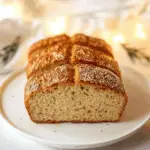If you’re following a low-carb or keto lifestyle and missing the tangy, chewy goodness of sourdough bread, then The Best Keto Sourdough Bread is here to save the day. This innovative recipe combines the natural fermentation process of traditional sourdough with keto-friendly ingredients like almond flour, coconut flour, and psyllium husk to create a loaf that’s both satisfyingly dense and delightfully tangy. Perfect for sandwiches, toast, or simply savoring on its own, this bread delivers all the comforting flavors and textures of classic sourdough without the carb overload. In this article, we’ll explore everything you need to know about making The Best Keto Sourdough Bread—from creating your own keto sourdough starter to step-by-step instructions on how to bake it at home. Let’s dive into this game-changing creation!
What Is Keto Sourdough Bread?
Keto Sourdough Bread is a low-carb, high-fat alternative to traditional sourdough bread, designed to fit seamlessly into a ketogenic diet. Instead of using refined wheat flour, this recipe relies on almond flour, coconut flour, or a blend of both, along with psyllium husk (for structure) and eggs to mimic the texture of traditional bread. The sourdough flavor comes from a keto-friendly sourdough starter made with almond flour and water, which ferments over several days to develop its signature tang. Once baked, the bread has a golden crust, a tender interior, and a rich, slightly sour flavor that pairs beautifully with butter, avocado, or your favorite toppings.
This recipe is ideal for anyone who loves the idea of indulging in sourdough bread but needs something low-carb and sugar-free. Its versatility makes it suitable for breakfast, lunch, dinner, or snacks.
Why You’ll Love This Keto Sourdough Bread Recipe
There are countless reasons why this bread has become a staple among keto dieters and sourdough enthusiasts:
- Low-Carb Comfort : Enjoy the tangy, satisfying flavors of sourdough bread without the carb-heavy ingredients.
- Fermented Goodness : The natural fermentation process enhances digestibility and adds beneficial probiotics.
- Customizable : Adjust the fermentation time, add-ins, or baking method to suit your taste preferences.
- Meal Prep Friendly : Bake a loaf ahead of time and store it in the fridge or freezer for quick meals throughout the week.
- Kid-Friendly : Kids love the soft texture, while adults appreciate the healthier twist.
- Versatile Uses : Great for sandwiches, avocado toast, French toast, or simply as a side for soups and salads.
Health Benefits of Keto Sourdough Bread
While this bread is indulgent in flavor, it offers several health-conscious advantages:
- Low in Carbs : Using almond flour and coconut flour ensures the bread stays low in net carbs, making it suitable for a ketogenic diet.
- Rich in Healthy Fats : Almond flour, coconut flour, and eggs provide heart-healthy fats that support sustained energy.
- Packed with Nutrients : Almond flour is rich in vitamin E, magnesium, and antioxidants, while psyllium husk adds fiber for digestive health.
- Probiotic Benefits : The fermentation process introduces beneficial bacteria that support gut health.
To make this recipe even healthier, consider adding nutrient-dense mix-ins like chia seeds, flaxseeds, or unsweetened shredded coconut, or serving smaller portions with a side of fresh berries.
Ingredients You’ll Need
Here’s what you’ll need to create The Best Keto Sourdough Bread:
For the Starter:
- Almond Flour : Provides structure and a nutty flavor.
- Filtered Water : Helps activate the fermentation process.
- Optional Sweetener : A small amount of erythritol or monk fruit can jumpstart fermentation.
For the Bread:
- Keto Sourdough Starter : The fermented base for the bread.
- Almond Flour : Provides structure and texture.
- Coconut Flour : Adds density and helps absorb moisture.
- Psyllium Husk Powder : Acts as a binder and gives the bread its bread-like texture.
- Eggs : Acts as a binder and adds structure.
- Melted Butter (or Coconut Oil) : Adds richness and enhances the bread texture.
- Baking Powder : Helps the bread rise for a light, fluffy texture.
- Salt : Balances the tangy sourdough flavor.
- Optional Mix-Ins : Sesame seeds, poppy seeds, or shredded cheese for added flavor and texture.
Step-by-Step Recipe Guide
Creating the Keto Sourdough Starter
- Day 1 : Combine ¼ cup almond flour and ¼ cup filtered water in a jar. Stir well, cover loosely, and let sit at room temperature for 24 hours.
- Day 2–5 : Each day, discard half of the mixture and feed it with another ¼ cup almond flour and ¼ cup filtered water. Stir well and let sit at room temperature. By Day 5, the starter should be bubbly and have a tangy aroma.
Preparing the Dough
- Preheat Your Oven : Set your oven to 350°F (175°C) and line a loaf pan with parchment paper or grease it lightly.
- Mix Wet Ingredients : In a large bowl, whisk together keto sourdough starter, melted butter (or coconut oil), eggs, and optional sweetener.
- Add Dry Ingredients : Stir in almond flour, coconut flour, psyllium husk powder, baking powder, and salt until the batter is smooth and well-combined. Let the batter rest for 2–3 minutes to thicken.
Baking the Bread
- Pour into Pan : Transfer the batter to the prepared loaf pan, smoothing the top with a spatula.
- Bake Until Golden : Bake the bread for 45–55 minutes, or until a toothpick inserted into the center comes out clean (a few crumbs are okay).
- Cool Completely : Let the bread cool in the pan for 10 minutes, then transfer to a wire rack to cool completely before slicing.
Creative Variations
The beauty of keto sourdough bread lies in its adaptability. Here are some fun ideas to try:
- Herb Bread : Add dried rosemary, thyme, or oregano for a savory twist.
- Cheese Bread : Fold shredded cheese (like cheddar or Parmesan) into the batter for a cheesy flavor.
- Seeded Bread : Sprinkle sesame seeds, flaxseeds, or sunflower seeds on top before baking for added crunch.
- Sweet Bread : Add cinnamon and a sugar-free sweetener for a lightly sweetened version, perfect for toast with butter.
- Gluten-Free Option : This recipe is naturally gluten-free, but ensure all packaged ingredients (like psyllium husk) are certified gluten-free if needed.
Tips for Perfect Results
- Use Fresh Ingredients : Fresh almond flour and high-quality psyllium husk ensure the best flavor and texture.
- Don’t Skip the Resting Time : Letting the batter rest allows the psyllium husk to thicken, creating a better texture.
- Adjust Water as Needed : Depending on the brand of psyllium husk, you may need to adjust the water slightly to achieve the right consistency.
- Freeze for Later : Slice the bread and freeze individual portions for grab-and-go convenience.
Serving Suggestions
Keto sourdough bread pairs wonderfully with a variety of accompaniments:
- Avocado Toast : Top with mashed avocado, sea salt, and red pepper flakes for a quick, nutrient-packed breakfast.
- Sandwiches : Use the bread for keto-friendly sandwiches with turkey, cheese, and lettuce.
- French Toast : Dip slices in an egg mixture, cook in butter, and serve with sugar-free syrup for a decadent treat.
- Soups and Salads : Serve alongside keto-friendly soups or salads for added texture and satisfaction.
For a fun presentation, garnish the bread with fresh herbs, a sprinkle of seeds, or a drizzle of olive oil.
Common Mistakes to Avoid
Even simple recipes can go awry if you’re not careful. Here are some pitfalls to watch out for:
- Skipping the Psyllium Husk : Not using psyllium husk can result in a dense, crumbly loaf. Always include it for structure.
- Overmixing the Batter : Overmixing can make the bread dense. Mix just until combined.
- Not Cooling Completely : Rushing the cooling process can cause the bread to crumble. Allow adequate time for cooling.
- Using Expired Ingredients : Old almond flour or psyllium husk can affect the flavor and texture. Use fresh ingredients for the best results.
FAQs About Keto Sourdough Bread
Q: Can I make this bread ahead of time? A: Yes! Store the bread in an airtight container in the refrigerator for up to 5 days or freeze for longer storage.
Q: How do I store leftovers? A: Store the bread in an airtight container at room temperature for up to 3 days, in the refrigerator for up to a week, or freeze for up to 3 months.
Q: Can I use flaxseed meal instead of psyllium husk? A: Flaxseed meal can work as a substitute, but the texture may differ slightly. Psyllium husk is recommended for the best results.
Q: Why is my bread too dense? A: Dense bread can occur from overmixing the batter or not using enough leavening agents. Be gentle when mixing and measure ingredients carefully.
Conclusion
The Best Keto Sourdough Bread is a game-changer for anyone following a low-carb or ketogenic lifestyle. Whether you’re craving a classic sandwich, a slice of warm toast, or a side for your favorite soup, this bread delivers all the comfort of traditional sourdough without the carb overload. Best of all, it’s highly customizable, requiring just a few pantry staples and your creativity.
Ready to give it a try? Gather your ingredients, follow our foolproof guide, and prepare to wow your family and friends with these delicious creations. Don’t forget to share your keto sourdough bread with us—we’d love to hear how it turned out!
By incorporating relevant keywords such as “low-carb sourdough bread,” “keto-friendly baking,” and “gluten-free bread” throughout the article, this piece is optimized for search engines while remaining engaging and informative for readers. Happy baking!
Print
The Best Keto Sourdough Bread: A Low-Carb, High-Fat Twist on a Timeless Classic
- Total Time: 55 mins
Description
Tangy, chewy, and perfectly low-carb — this keto sourdough bread is soft on the inside, crisp on the outside, and made with simple ingredients for that classic sourdough flavor without the carbs!
Ingredients
1 cup almond flour
¼ cup coconut flour
½ tsp baking powder (aluminum-free)
¼ tsp baking soda
½ tsp salt
1 tbsp psyllium husk powder (or ground flaxseed for binding)
1 cup warm water (about 110°F / 45°C)
2 large eggs
¼ cup apple cider vinegar or lemon juice (to activate baking soda)
¼ cup melted coconut oil or butter
Optional: ½ tsp active dry yeast for extra rise (not strictly keto but optional for texture)
Optional: Sesame seeds, poppy seeds, or garlic powder for topping
Instructions
Preheat oven to 350°F (175°C). Line an 8×4-inch loaf pan with parchment paper.
In a bowl, mix almond flour , coconut flour , baking powder , baking soda , and salt .
Add psyllium husk powder , stirring well to avoid clumps.
In another bowl, combine warm water , apple cider vinegar , and melted oil .
Whisk in eggs one at a time until fully blended.
Gradually mix wet ingredients into the dry until a thick, sticky dough forms.
Let dough rest for 5–10 minutes to allow the psyllium to swell.
Shape into a loaf and place in the prepared pan. Optional: Sprinkle with seeds or herbs.
Bake for 40–45 minutes until golden brown and sounds hollow when tapped.
Cool completely on a wire rack before slicing — it firms up as it cools!
- Prep Time: 10 mins
- Cook Time: 45 mins
Nutrition
- Serving Size: 10 slices
- Calories: 140
- Fat: 12g
- Carbohydrates: 4g
- Protein: 5g
